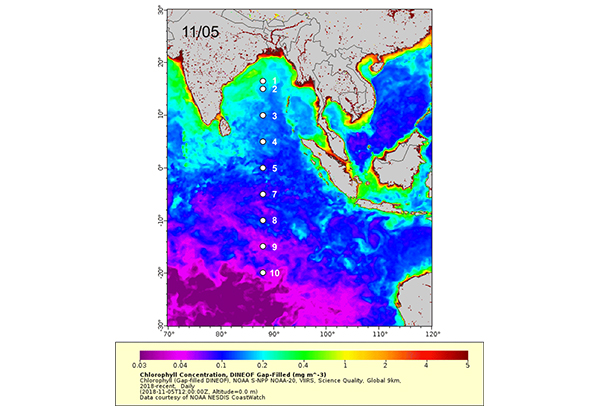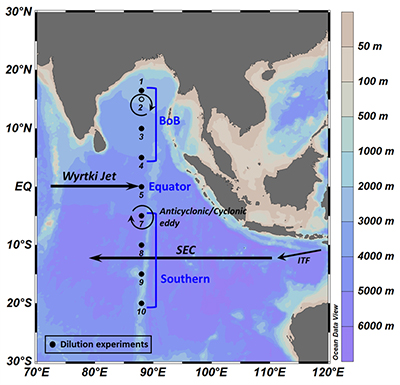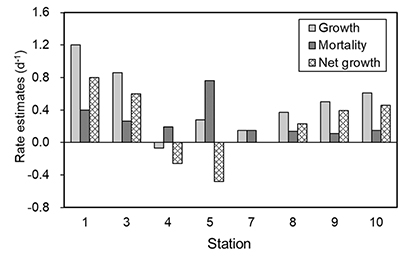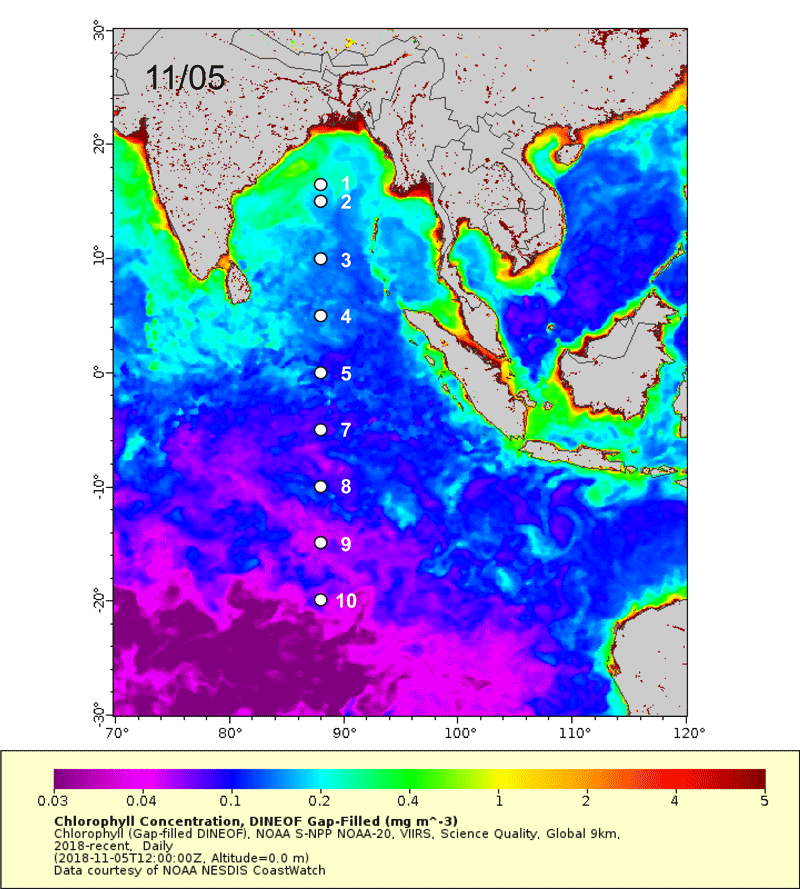Phytoplankton dynamics as a response to physical events in the oligotrophic Eastern Indian Ocean
18 April, 2022
Siyu Jiang (Atmosphere and Ocean Research Institute, The University of Tokyo)
Fuminori Hashihama (Tokyo University of Marine Science and Technology)
Yukio Masumoto (Graduate School of Science, The University of Tokyo)
Hongbin Liu (Hong Kong University of Science and Technology)
Hiroshi Ogawa (Atmosphere and Ocean Research Institute, The University of Tokyo)
Hiroaki Saito (Atmosphere and Ocean Research Institute, The University of Tokyo)

The Eastern Indian Ocean (EIO) has been considered as an oligotrophic*1 and unproductive marine ecosystem. However, various physical events occur throughout the year are expected to cause biological responses. For the first time, a series of in situ incubation experiments were conducted in the EIO to understand the responses of phytoplankton to physical events. The obtained results revealed that the EIO marine ecosystem was not always stable/homogenous with a low phytoplankton biomass (as represented by Chl a concentration). As instead, various physical events could increase the Chl a concentration, and possibly further affect the higher trophic levels (fish ect.) or other benefits of this marine ecosystem.
1. Background
The Eastern Indian Ocean (EIO) is an important marine ecosystem that supplies food, natural resources, and other benefits to the surrounding countries. However, compared with Atlantic and Pacific Oceans, our understanding of EIO is very limited because of the scarce in situ observations. For instance, our previous understanding of EIO is it has a continuously low phytoplankton biomass (i.e., low Chl a concentration) because of the continuous deficiency of nutrients. However, the increased Chl a concentrations (phytoplankton blooms) were occasionally detected by mooring or remote sensing observations and had been hypothesized as induced by the frequently occurred physical events in this area. The underlying formation mechanism of phytoplankton bloom is still unclear because of lacking associated in situ observations. This study was designed to fill this gap of knowledge by conducting in situ incubation experiments combined with the analysis of a series physical, chemical and biological data (Figure 1).
2. Results
In this study, the phytoplankton blooms were detected by both the cruise and remote sensing in different regions of EIO (Animation 1). However, the nutrient concentration (especially nitrogen) was consistently low and was incapable of supporting these high Chl a concentrations. The incubation experiments which measured the phytoplankton growth rate and mortality rate due to microzooplankton*2 grazing provided the critical information to this mystery. Firstly, at all bloom stations (stations 4, 5 and 7), the phytoplankton net growth rate was zero or negative (i.e., growth was lower than mortality, Figure 2), indicating the high Chl a concentrations would decrease after the cruise. The remote sensing data also demonstrated these high values disappeared soon (Animation 1). Secondly, the nutrient (nitrogen) enrichment in the incubation experiment increased the phytoplankton growth rate by ~4.9 times at the bloom stations, indicating it was the nutrient scarcity limited the phytoplankton growth and the further Chl a increase. These results collectively suggested the phytoplankton bloom we observed was initiated by nutrient enrichment but ceased by nutrient exhaustion. To further figure out whether the nutrient enrichment was supplied by physical events, we collected the remote sensing data of sea surface wind, current and sea surface height to verify the occurrence of physical event. These data suggest the nutrient enrichment was supplied from the subsurface seawater by a cyclonic eddy*3 in the southern EIO (station 7), or by a fast Equator surface current named Wyrtki Jet (stations 4 and 5). In the latter case, the current firstly hit the Maldives, induced the upward nutrient enrichment and Chl a increase at western of our study area, and then transferred the Chl a-rich water eastward. This equatorial eastward zonal high Chl a concertation could also be observed by the remote sensing data (Animation 1).
3. Future Perspective
This study conducted the in situ incubation experiments and measured the phytoplankton growth and mortality rates for the first time in the EIO. Combining the analysis of remote sensing, we uncovered the formation mechanism of phytoplankton bloom in this area and demonstrated the EIO is not always an ocean desert as traditionally considered. As instead, it is quite dynamic through the responses of ecosystem components to nutrient enrichment induced by physical events. Further studies are still required to understand the potential effect of this ecosystem dynamic on higher trophic levels and the whole ecosystem.

Figure 1. Map of incubation experiments (solid circle) during the cruise, and the current system and physical events in the EIO (black arrow, SEC: South Equatorial current, ITF: Indonesia Throughflow).

Figure 2. Phytoplankton growth rate, mortality rate due to microzooplankton grazing and net growth rate (growth minus mortality).

Animation 1. Time series of remote sensing Chl a concentration before and during the cruise. High Chl a concentrations (> 0.2mg m-3) were observed at the Equator, in the northern and southern EIO. The dots indicate the sampling stations.
Journal:「Progress in Oceanography」Volume 203, April–May 2022(on-line March 21, 2022)
Title of paper:Phytoplankton dynamics as a response to physical events in the oligotrophic Eastern Indian Ocean
Authors:Siyu Jiang*, Fuminori Hashihama, Yukio Masumoto, Hongbin Liu, Hiroshi Ogawa, Hiroaki Saito
DOI:10.1016/j.pocean.2022.102784
URL:https://doi.org/10.1016/j.pocean.2022.102784![]()
Contact
Siyu Jiang jiangsiyu[at]aori.u-tokyo.ac.jp
Glossary
*1 oligotrophic: to describe an environment in which there are extremely low levels of nutrients
*2 microzooplankton: the main consumer of phytoplankton primary production (including e.g., nanoflagellates, ciliates, dinoflagellates, and metazoan nauplii)
*3 cyclonic eddy: a circular current of water causing upwelling at its core
![]()



